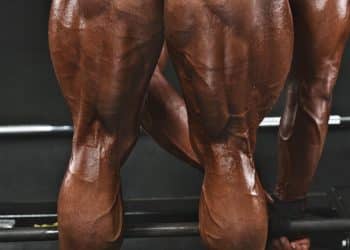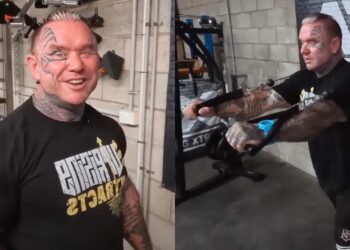The kneeling leg curl or iso-lateral hamstring curl is an effective exercise that targets the hamstrings muscles on the lower posterior chain (Backside of the body). Since the leg curl is an isolation exercise, many people do it after a compound exercise (e.g. Squats, deadlift, leg press) and it is a great finisher to a leg workout. However, it’s also great as a stand-alone exercise for the hamstrings.
But, the great thing about the kneeling leg curl is that you can work each hamstring separately which improves balance and unilateral strength in each muscle. The kneeling leg curl is highly recommended in any leg workout routine for maximum gains.
How To Do Kneeling Leg Curls
In this section, we’ve provided detailed step-by-step exercise instructions to help you get the most out of kneeling leg curls.
Note: There are different versions of the kneeling leg curl machine and depending on your experience with training equipment there may be a brief learning curve. Refer to the machine instructions and don’t be afraid to ask for help adjusting and using the machine if needed.
To do it:
- Choose the desired weight. We recommend starting light unless your hamstrings are already warmed up.
- Position yourself so that the foam roller is against the back of your lower leg and a few inches below the calf muscle.
- Place the non-working leg on the padded knee rest then lean your upper body forward onto the top pad with your forearms and grab onto the handles with both hands. Your working leg should be fully extended before performing the leg curl.
- Press your hips into the machine pad then bend your knee and flex the hamstring to curl the weight all the way up until the roller touch your glutes. Exhale during this portion of the exercise.
- Now slowly extend the leg until you feel a decent stretch in the hamstrings. Inhale during this portion of the exercise.
- Complete the desired number of repetitions then adjust the knee pad for the opposite leg and repeat.
Pro tip: Dorsiflex the toes (lift them up toward the shin) to activate more of the hamstrings. Point the toes down to engage more of the calf muscles.
Level Up Your Fitness: Join our 💪 strong community in Fitness Volt Newsletter. Get daily inspiration, expert-backed workouts, nutrition tips, the latest in strength sports, and the support you need to reach your goals. Subscribe for free!
Check out the video below for a demonstration of the kneeling leg curl with an explanation of the steps.
Common Mistakes
If you’re going to do kneeling leg curls, do them right. Here are some exercise mistakes that you should avoid.
Not adjusting the machine to you
Machines can be intimidating because they have a lot of moving parts. As a result, many will either use the machine how the last person left it (may be fine) or try to adjust it and give up because it’s too complex. This is a big mistake because you need the machine to fit your height and comfort as it plays a big part in your performance.
Take a few minutes to read the instructions and learn about the machines you’re using or ask someone for help.
Using too much weight
This one could apply to any weighted exercise and it’s one of the most important training dont’s. If the weight is so heavy that you’re using everything but your hamstrings to curl the weight then you’re doing it wrong. There’s a time and place for momentum reps but you should still be using good technique.
The problem is when people ego lift or don’t want to seem weak to others and they end up lifting above their capabilities. Choose a weight that is challenging but that still allows you to focus on maintaining good form.
Kneeling Leg Curl Benefits
Why is the kneeling leg curl a good choice for targeting the hamstrings?
A great calf workout
That wasn’t a typo… while leg curls target the hamstrings, the calves are still engaged and involved in bringing the heel to the butt. And as mentioned, you can give them more stimulation by pointing the toes down toward the floor before performing the curl.
An even better hamstring builder
While squats other compound lifts activate the hamstrings, to fully work the hamstring muscles you need at least one curl variation in your rotation. That’s because the short head of the biceps femoris (one of the hamstring muscles) crosses the knee joint. Therefore, you can only activate it through knee flexion.
You can achieve this by using any of the curl variations or alternatives also included in this guide.
Promotes healthy muscles and prevents injuries
Similar to the rear deltoids and back, we rarely see these muscles unlike the chest, abs and quads. Consequently, these muscles tend to be neglected or forgotten altogether and this can lead to muscle imbalances. Make sure to give equal attention to all of your muscle groups if you want to maintain a strong, balanced physique and minimize injuries.
Keeps you upright
The one big advantage that the kneeling and seated leg curl has over lying leg curls is that you don’t have to lie face down on a bench to do them. This can be very uncomfortable or undesirable for many exercisers for various reasons.
Variety
Sometimes even though two exercise variations involve the same movement, the position of your body can make them feel different and you may prefer one over the other. For example, you may like the kneeling leg curl better than the lying or seated variation and vice versa. Pick the one that you like best.
Drawbacks
Now let’s talk about some of the potential kneeling leg curl negatives.
Requires a dedicated kneeling leg curl machine
If you don’t have a gym membership or your facility doesn’t have a kneeling leg curl machine then you’re going to have to seek out one of the options from the variations or alternatives section below.
Variations and Alternatives
These variations and alternative give you more options to train your hamstrings whether you prefer one technique over the other or don’t have access to training equipment.
Level Up Your Fitness: Join our 💪 strong community in Fitness Volt Newsletter. Get daily inspiration, expert-backed workouts, nutrition tips, the latest in strength sports, and the support you need to reach your goals. Subscribe for free!
1. Lying leg curl
Perhaps the most popular hamstring curl variation, the lying leg curl is an old-school classic that still deserves a place in your posterior muscle workouts. It’s done by lying face down on a bench and lifting your feet up toward the ceiling.
2. Seated leg curl
Pretty much a reverse leg extension, the seated curl is also a great variation that allows you to train the hamstrings using a different position.
3. Inverse leg curl
An inverse leg curl uses your own bodyweight and is performed exactly as its name implies. Your body moves while the feet remain secured to the implement. For that reason, we’d say it’s more of an intermediate variation. There are also a few different versions of this exercise.
4. Stability ball curls
Don’t have access to a leg curl machine? Or maybe you prefer to train at home. Stability balls are a relatively inexpensive training tool that can add range of motion and increased stability demand to your workouts and there’s a reason why many people still use them. They simply work!
5. Floor slides
Floor slides are the ultimate equipment-free hamstring exercise perfect for home and travel workouts. But keep in mind, they aren’t necessarily beginner friendly because the resistance is your bodyweight and you cannot change it.
The best way to do these is to wear socks on a slippery floor surface.
To do it:
- Lie on your back and place your arms down by your sides or behind your head.
- Lift your hips toward the ceiling and slide your heels into your butt, concentrating on contracting the hamstring muscles. Slide your feet back to the starting position and repeat.
Watch the video tutorial below to see how it’s done.
6. Resistance band variations
Another method that works is using a loop resistance band and you can replicate a lying or standing leg curl by anchoring one end around the non working leg or an object.
7. Dumbbell leg curl
An alternative to a machine leg curl is to lie face down while holding a dumbbell between the feet and replicating the hamstring curl movement. It can be a little dangerous though and it’s harder to maintain tension on the hamstrings.
This would be our least favorite choice but hey, it’s better than nothing.
Related: 15 Best Leg Curl Alternatives for Stronger Hamstrings
How To Program Kneeling Leg Curls
Leg curl variations are versatile because you can use them as a standalone hamstring exercise, as a pre leg workout warmup or to finish off your leg training. But however you choose to include them, do so with the same intensity and focus as you would any other exercise.
- Standalone – leg curls make for the perfect exercise for the days when you’re short on time or you don’t want to do a full hamstrings workout but still want to stimulate them. This will also allow you to focus your energy and strength into maximizing each repetition.
- Warmup – Get some blood flowing to your knees before a big leg workout with a couple sets of light-moderate resistance hamstring curls.
- Finisher – A great conclusion to your leg training sessions, leg curls are less intense than compound lifts which makes them a food finishing movement. That doesn’t mean you should treat them like an afterthought though. Perform your reps nice and slow focusing on moving the weight with your hamstrings.
Sets and Reps
Are there an ideal number of sets and reps for the kneeling leg curl? The short answer is no. You’ll need to determine this based on the frequency of your training, how you structure your workouts and other factors such as energy levels.
Here are some recommendations based on training goals. Although we do recommend utilizing a variety of rep ranges.
- Hypertrophy: 3-4 sets x 8-25 reps
Muscles Worked
Learning the anatomy of the muscles being trained will help you to perform the exercise with correct technique and shift your focus where it needs to be to stimulate maximum gains.
Hamstrings – The hamstrings is a three-headed muscle group consisting of semitendinosus, semimembranosus, and biceps femoris. Located on the back of the upper leg opposite the quads, they function to extend the hips and flex the knees. The short head of the biceps femoris only crosses the knee joint and not the hip like the other two muscles. Consequently, it’s important to include leg curl variations to hit this muscle.
It’s important that you give enough attention to these muscles for a balanced and aesthetic lower body.
Calves – The calves make up the lower leg muscles below the knee. They function to point the toes down and are athletic muscles. All compound leg movements involve the calves.
Bottom Line
The kneeling leg curl is just another way to isolate your hamstring muscles and it’s better than the lying leg curl and many of the variations and alternatives in many ways. If you’re not already incorporating this variation in your workouts we suggest you give it a try during your next training session.
Interested in measuring your progress? Check out our strength standards for Lying Leg Curl, Seated Leg Curl, Deadlift, and more.








